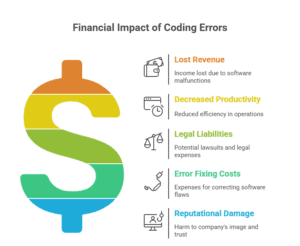The Financial Impact of Coding Errors in Hospital Revenue

In the complex landscape of healthcare finance, accurate medical coding plays a pivotal role in ensuring proper reimbursement for services rendered. Hospitals depend on coders to translate clinical documentation into standardized codes that determine billing, statistical tracking, and care evaluation. However, even minor coding errors can lead to substantial financial consequences. From revenue leakage to regulatory penalties, the implications of inaccurate coding extend beyond lost dollars they affect operational efficiency, compliance, and patient trust.
Understanding Medical Coding in Hospitals
Medical coding involves translating diagnoses, treatments, procedures, and equipment into alphanumeric codes, primarily using:
ICD-10-CM (International Classification of Diseases, Clinical Modification)
CPT/HCPCS (Current Procedural Terminology and Healthcare Common Procedure Coding System)
DRG/APC (Diagnosis-Related Group and Ambulatory Payment Classification)
These codes form the backbone of claims submitted to payers like Medicare, Medicaid, and private insurers. Coding accuracy determines whether a hospital is reimbursed fully, partially, or not at all for the care it delivers.
Types of Coding Errors
Upcoding: Assigning a higher-paying code than justified by documentation.
Undercoding: Assigning a lower-paying code, which may avoid scrutiny but causes revenue loss.
Omissions: Missing secondary diagnoses or procedures that support higher DRG/APC classifications.
Incorrect sequencing: Placing diagnoses or procedures in the wrong order can misrepresent case severity.
Mismatched documentation: When the code doesn’t align with the provider’s documentation, payers may deny the claim.
Financial Consequences of Coding Errors

1. Revenue Loss and Underpayment
Undercoding and omissions lead to substantial revenue leakage. According to HFMA reports, hospitals can lose 1%–5% of revenue due to incorrect or incomplete coding. For a mid-sized hospital billing $500 million annually, even a 1% error rate represents a $5 million loss.
2. Claim Denials and Delays
Payers often deny claims with vague, inaccurate, or mismatched codes. Denied claims require rework, which incurs administrative costs, prolongs the revenue cycle, and burdens the billing department. Some claims never get resubmitted, resulting in permanent revenue loss.
3. Compliance Risks and Penalties
Upcoding—whether intentional or not—can trigger audits, fraud investigations, and penalties. The Office of Inspector General (OIG) and Centers for Medicare & Medicaid Services (CMS) impose heavy fines for non-compliance. In severe cases, hospitals may face exclusion from federal programs.
4. Reduced Quality Metrics and Reputation
Many value-based payment programs link reimbursement to coding-derived metrics like complication rates, readmissions, or case severity. Inaccurate coding may misrepresent care quality, resulting in lower reimbursement rates and reputational damage.
Root Causes of Coding Errors
Inadequate documentation by providers
Lack of coder training or specialization
High coder turnover and staff shortages
Insufficient use of audit and compliance tools
Poor EHR integration or automation
Mitigation Strategies
Invest in Clinical Documentation Improvement (CDI) Programs
Ensuring physicians document with precision supports more accurate and compliant coding.
Ongoing Coder Training and Certification
Continuous education keeps coders updated on evolving coding standards and payer requirements.
Regular Internal Audits
Conducting retrospective coding audits can help detect and correct recurring errors before external payers do.
Implementing Coding Analytics Tools
Use AI-driven tools to detect anomalies, predict denials, and suggest accurate codes based on clinical documentation.
Cross-Department Communication
Collaboration between providers, CDI teams, coders, and billers ensures clarity, consistency, and accuracy.

What Did We Learn?
The financial health of a hospital is intricately tied to the accuracy of its coding practices. Coding errors are not just clerical oversights—they are costly missteps that jeopardize revenue integrity, compliance, and patient care metrics. Hospitals must view coding accuracy as a strategic priority, supported by technology, training, and robust compliance infrastructure. By doing so, they not only safeguard revenue but also reinforce trust in the quality of care they provide.
What People Are Asking?
1. What is a coding error in healthcare?
A coding error occurs when diagnoses or procedures are incorrectly coded, omitted, or not properly documented, affecting billing and reimbursement.
2. How do coding errors affect hospital revenue?
They lead to claim denials, underpayments, delayed reimbursements, and in some cases, compliance penalties—costing hospitals millions annually.
3. What is the most common financial risk from coding mistakes?
Undercoding, which causes hospitals to be paid less than they are owed for services provided.
4. Can coding errors trigger legal issues?
Yes. Upcoding or fraudulent coding practices can result in audits, fines, and exclusion from Medicare/Medicaid programs.
5. How can hospitals reduce coding-related revenue loss?
By improving provider documentation, training coders, using audits, and adopting AI-based coding support tools.
Disclaimer:
For informational purposes only; not applicable to specific situations.
For tailored support and professional services
Please contact Staffingly, Inc. at (800) 489-5877
Email: support@staffingly.com
About This Blog: This Blog is brought to you by Staffingly, Inc., a trusted name in healthcare outsourcing. The team of skilled healthcare specialists and content creators is dedicated to improving the quality and efficiency of healthcare services. The team passionate about sharing knowledge through insightful articles, blogs, and other educational resources.
 Book a Demo to Build Your Team Today!
Book a Demo to Build Your Team Today!



 Read Case Studies
Read Case Studies 


 Virtual Medical Assistants
Virtual Medical Assistants



